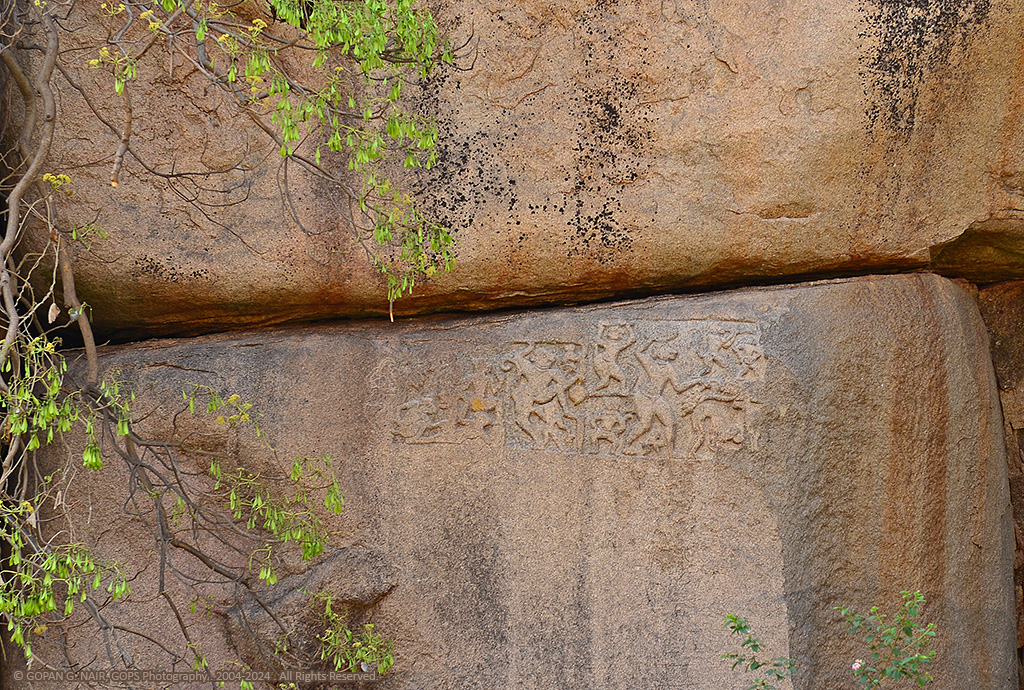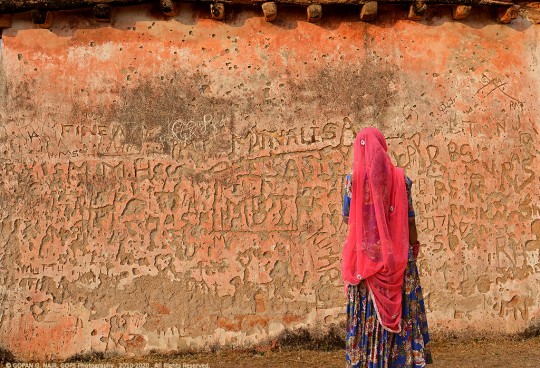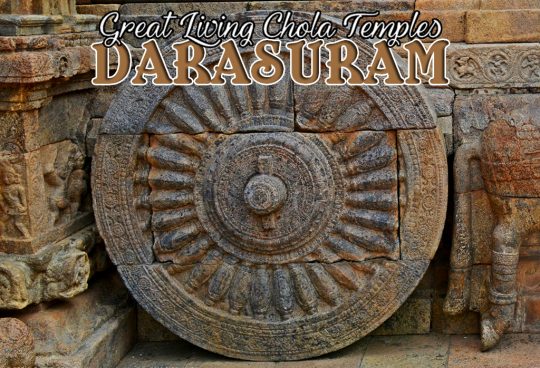Let’s take a journey back in time as we explore the history spanning over 5000 years. Our story begins with the river Pampa (Tungabhadra), the lifeblood of a great civilization that once thrived in the southern state of Karnataka in India.
Anegundi is a serene village located just opposite to Hampi, on the northern bank of the river Tungabhadra; a place where evolution, history, mythology and folklore intertwine. The name Anegundi (or Anegondi, ಆನೆಗುಂದಿ/ಆನೆಗೊಂದಿ) originates from the Kannada language, meaning “Elephant pit.” It was the early capital of the Vijayanagara empire before it was moved to Hampi, possibly deriving its name from the king’s elephant stables that were originally situated here. For more in-depth information about Hampi & the Vijayanagara empire, you can look at [here].
According to experts in earth sciences, the rock formations in this area are estimated to be around 3000 million years old, making it one of the oldest plateaus on our planet. This suggests that it was among the first locations to solidify during the earth’s cooling process.
Anegundi has been identified as having traces of early human settlements. The presence of Neolithic (Stone Age) burial grounds and primitive cave paintings in this area attracts the interest of research students, historians, and geologists alike. To learn more about the ancient settlements and burial sites in this area, feel free to explore my blog on Hirebenkal.
Anegundi brims with history and mythology, and it might just be more captivating than Hampi itself. The place is steeped in the epic Ramayana, with a strong connection to it. Legend has it that Anegundi was once the mythical monkey kingdom of Kishkindha as described in the Ramayana. The presence of various monuments, temples, and scattered ruins in and around the area strongly supports this belief.
- CARVINGS DEPICTING STORIES FROM RAMAYANA
- SCENES FROM RAMAYANA FOUND EVERYWHERE
Exploring renowned sites such as Anjanadri Hill, Rishimuka Hill, Shabari’s Cave, Pampa Sarovar, Mathanga Hill (in Hampi), and more, transports you back to the era of Ramayana. These sites will be further elaborated on in this article.
Once you veer off from the main express highway and onto the narrow road, you’ll immediately notice a distinct change in the landscape. The sight of lush green paddy fields surrounded by abundant boulders, thriving plantain trees, and coconut farms on either side of the road truly accentuates the allure of this picturesque countryside. Driving through the village proved to be incredibly revitalizing. The locals, predominantly farmers and artisans, are known for their peaceful and welcoming nature. Despite the scarcity of hotels and restaurants in this small village, I was able to locate a comfortable cottage adjacent to a water theme park, managed by the Kishkindha trust.
As I strolled into the village, I encountered the remnants of the grand Bukka’s Aqueduct, a colossal stone structure that once transported water from the Tungabhadra river during ancient times. The Vijayanagara rulers had ingeniously maintained their land’s fertility through an extensive network of irrigation canals, supplying water to various tanks, ponds, and baths in their kingdom. It was truly remarkable to witness many of these 14th-century canals still in functional condition today.
This riverside area is also famously known as ‘hippie island’, serving as a haven for free-spirited travelers and backpackers from all corners of the globe. Here, one can find numerous hippies residing in economical huts and laid-back cafes, engaged in playing musical instruments, socializing over drinks, dancing, and occasionally partaking in forbidden substances!
The ancient stone bridge that once connected Hampi and Anegundi still rests where it fell. Despite a modern hanging bridge being constructed, it succumbed to natural disasters, claiming the lives of some workers. Superstition has since prevented the construction of another bridge at this location. The government has initiated a new bridge project further downstream (Bukkasagar bridge), which is now in operation.
I’ve found that there are regular ferry services and coracle rides available across Hampi and Anegundi. The river crossing itself can take less than 2 minutes, and it’s quite fascinating to see commuters with their motorbikes, shepherds with their lambs, local women carrying firewood, and even Western tourists, all sharing the ferry happily. Additionally, there’s the option to use the newly constructed Bukkasagar bridge, which is located 12 kilometers away from Hampi.
Exploring Hampi and Anegundi on our own is fascinating, but having a guide would be very beneficial in finding specific locations. Navabrindavana, a small island in the Tungabhadra River between Hampi and Anegundi, is renowned for the nine samadhis of nine prominent saints. A short ride on a coracle will take you to this unique place.
Close by, there was an additional mandap with 64 pillars, believed to be the ultimate resting place of King Krishnadevaraya. King Krishnadevaraya was renowned for being a master in 64 different art forms (vidyas), which is why there are 64 pillars in his tomb. As I started to make my way through the shallow waters towards the mandap, I caught sight of some troublemakers engaging in illicit activities, prompting me to trust my instincts and turn back.
A leisurely walk through the heart of Anegundi town proved to be truly captivating. Resembling other ancient Indian cities, the narrow winding streets lined with vibrantly colored houses added charm to the quaint town. Each welcoming face I encountered wore a genuine smile and willingly posed for my camera.
Exploring Anegundi town and its surroundings occupied our entire day. The abandoned Gagan Mahal, once the grand palace of the Vijayanagara rulers, sits in the center of the town. Constructed in the 16th century, this magnificent palace suffered damage during Mughal invasions and has remained neglected since the empire’s downfall in 1565 A.D.
A large wooden chariot, which belongs to Lord Vishnu, is positioned in front of the palace, facing Ranganathaswamy Temple. This chariot is utilized for the procession during the Ranganatha festival, which takes place annually in April.
We discovered that the region was rich in a variety of banana known as Sugandhi (referred to as Palayamkodan പാളയംകോടൻ in Kerala). This particular type of banana is renowned for its digestive properties and is also a favorite treat among monkeys. As we made our way back to the hotel, we purchased a cluster of Sugandhi bananas for ourselves and to share with our primate companions.
I had already finalized my plans for the following day. The main objective was to witness the sunrise from Anjanadri Hill, a small hillock believed to be the birthplace of Hanuman, the monkey god. At the summit of the hill sits a small Anjaneya temple, which is likely the highest point in Anegundi, offering a panoramic view of the entire area. Arriving at the foothills around 5:30 AM while it was still dark, I promptly began my ascent. The climb of 575 steps proved to be quite challenging, yet I managed to reach the top in just under half an hour.
Despite the strenuous climb, the experience was truly rewarding. Upon reaching the summit, I found several foreign travelers already present, eagerly awaiting the sunrise. A group of priests sat in front of the Hanuman temple, singing bhajans, while mischievous monkeys roamed about. As the sun began to rise on the horizon, I positioned myself by a fence for a better view and became captivated by the breathtaking scenery. Suddenly, I was interrupted by a young French girl trying to get my attention. It took me a moment to realize she was pointing at a small monkey making off with my camera bag. Without hesitation, I leaped from the fence and chased after the playful thief. Fortunately, the monkey only had eyes for my water bottle and meant no harm to my bag.
The sight of the Tungabhadra river illuminated by the morning sun was truly magnificent. The Vittala temple and Matanga hill were also clearly visible from the hilltop. As I descended, I took more photographs of the lush green valley adorned with banana plantations, paddy fields, and coconut farms.
I had previously read tales of the battle between monkey kings Bali (Vali) and Sugriva in the epic Ramayana. My local guide was enthusiastic about showing me the significant locations from this mythical narrative.
One of these locations was Chintamani Temple, where Bali was struck by Lord Rama’s arrow and perished. Unfortunately, the area was quite filthy and I did not wish to linger there. Our next destination was Shabari’s cave, where Lord Rama was welcomed by an elderly female ascetic named Shabari. The hermitage was situated next to a large pond known as Pampa Sarovar. The footprints of Lord Rama are still revered here with immense devotion. I happened to observe a detailed map of India on the wall, depicting the path taken by Rama during his exile. If the events of the Ramayana truly occurred, the locations and route align perfectly. Take a look at the map below and share your thoughts with me.
Anegundi boasts a fortress with multiple entrances, the primary one being located beyond the Durga Temple atop Vali Quila (Bali’s Hill). Legend has it that this stronghold was once the domain of the monkey king Bali, ruling over Kishkindha. Our journey to Vali Quila took us through the Durga Temple, where a unique custom within the shrine captured my interest. Adorned with vibrant fabrics, hundreds of coconuts hung from a tree, offerings made by worshippers in hopes of having their desires granted.
The stone-laden path located at the rear of the temple leads to a perilous trail that ascends to the peak of a hill. Along the way, our guide indicated the cave that Sugriva had sealed, while Bali was engaged in combat with a demon known as Mayavi. The hill was strewn with mounds of boulders and observation towers, giving me reason to believe that this area could be linked to the monkey kingdom. From the cliff’s summit, there was a clear view of Pampa Sarovar and Anajanadri.
The Rishimukh hill is considered to be another location where Sugriva sought refuge from Bali’s threats. Upon examining the locations of Kishkindha, Rishimukh, Matanga hill, and others, the narrative of the Ramayana appeared to be quite compelling.
Our subsequent stop was Onake Kindi, where we observed ancient cave drawings from 2000 BC. Despite the absence of any signage, our guide led us through paddy fields, coconut plantations, and desolate terrain until we arrived at a cave displaying evidence of early human habitation.
Several caves displayed ancient paintings of humans, horses, cattle, and hunting scenes. Additionally, I discovered a depiction of a large serpent and various symbols or logos on the upper part of the rock shelters.
I believe my journey was not fully satisfying, yet it left a lasting impression. Hampi and Anegundi are destinations I wish to revisit repeatedly. Thank you for your precious time, and I trust you found this blog enjoyable.
Would you like to explore further the ancient human habitation in the region by exploring the ‘Valley of the dead’? Come along with me on the upcoming excursion to Hirebenkal .
How to Reach Anegundi :
- Bangalore -Tumkur -Hiriyur – Chitradurga – Hospet – Hampi -(by ferry)-Anegundi- 343 Km
- Bangalore -Tumkur -Hiriyur – Chitradurga – Hospet – Munirabad – Sanapur – Anegundi- 357 Km
- Bangalore -Tumkur -Hiriyur – Chitradurga – Hospet – Kamalapur – Kampli – Anegundi- 380 Km
- Bangalore -Tumkur -Hiriyur – Bellary- Hampi-(by ferry)-Anegundi – 368 Km
- Nearest Town: Hospet (13 km), Bellary (84 km)
- Nearest Railway Station: Hospet (13 km)
- Best Time to Visit: October to February

















































Kumari Hearth
June 09, 2016
Enjoyed seeing the lovely photographs and I felt as if i was taking a trip to the wonderful village. Excellent photography!!
GOPAN NAIR
June 10, 2016
Unlike the man-made cities, God made the country sides. Enjoy the villages, feel the life. Thanks once again for your valuable comments.
MARSHALL
February 23, 2017
WHAT A BEAUTIFULLY PHOTOGRAPHED, INSIGHTFUL AND INFORMATIVE PHOTOLOUGE-BRAVO. I JUST RETURNED FROM HAMPI/ANNEGUNDI,
GOPAN NAIR
February 24, 2017
Thank you very much for the encouraging words. Really appreciate it.
Let’s travel together to see this mysterious land !
SUBHASH HEGDE
December 20, 2018
What a fantastic piece of information, explained in simple language. Really loved traveling with you. Hope you would put together a book.
GOPAN NAIR
December 26, 2018
Thank you very much for your comments. Appreciate it.
Hima Shwetha GH
January 28, 2020
would you like a structure to preserve the rock art painting in onake kindi.
as it is affected by many ways, such as weathering ect.
GOPAN NAIR
February 02, 2020
Of course it would help. But what could we do about it ? Looks like the authorities have completely ignored such treasures.
Thanks for your visit and comments. You may please have a look at “Hire benakal” as well >> http://gops.org/?p=2078
Vinay Jambhekar
November 29, 2023
Hello Mr Nair. It was just by chance that I happened to see your blog on Anegundi. As a matter of fact, yours was the only blog giving details on places around Hampi having connection with Ramayana related places. I have been wanting to see these places since years but had no clue about the exact locations. My heartfelt and sincerest thanks for sharing this information. I am planning to visit Anegundi in the coming 2-3 months. I am sure, the information shared by you will prove to be of ample importance. Would you be kind enough to share either your e mail or mobile number.
GOPAN NAIR
November 29, 2023
Thanks for your valuable comments, dear Sir. People don’t read blogs in this vlog or YouTube world. Good to know that you enjoyed it. I will message you directly.